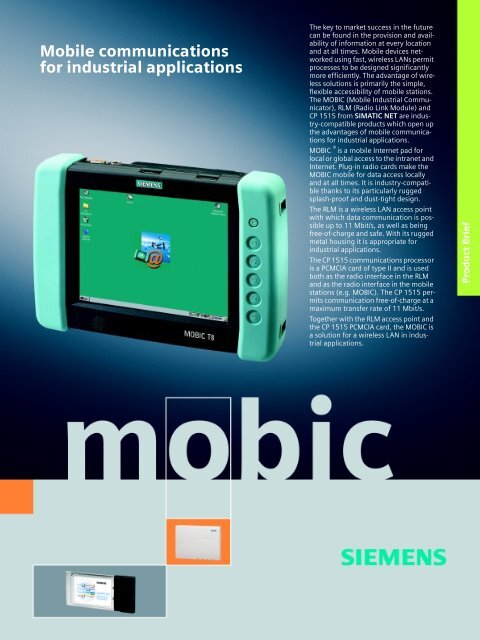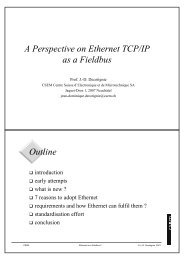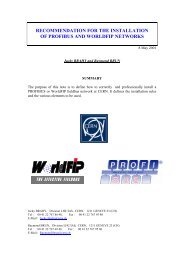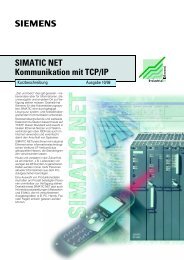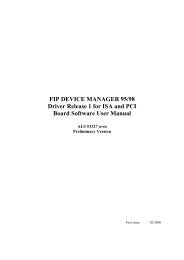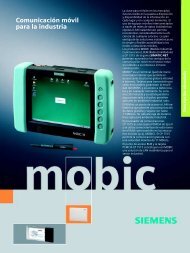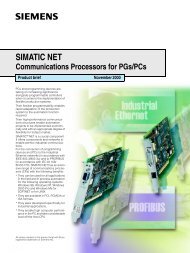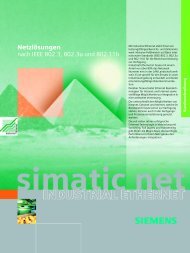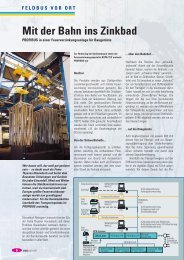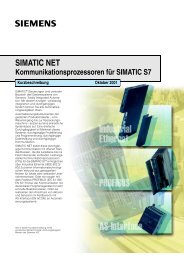Mobile communications for industrial applications - CERN
Mobile communications for industrial applications - CERN
Mobile communications for industrial applications - CERN
Create successful ePaper yourself
Turn your PDF publications into a flip-book with our unique Google optimized e-Paper software.
<strong>Mobile</strong> <strong>communications</strong><strong>for</strong> <strong>industrial</strong> <strong>applications</strong>The key to market success in the futurecan be found in the provision and availabilityof in<strong>for</strong>mation at every locationand at all times. <strong>Mobile</strong> devices networkedusing fast, wireless LANs permitprocesses to be designed significantlymore efficiently. The advantage of wirelesssolutions is primarily the simple,flexible accessibility of mobile stations.The MOBIC (<strong>Mobile</strong> Industrial Communicator),RLM (Radio Link Module) andCP 1515 from SIMATIC NET are industry-compatibleproducts which open upthe advantages of mobile <strong>communications</strong><strong>for</strong> <strong>industrial</strong> <strong>applications</strong>.MOBIC ® is a mobile Internet pad <strong>for</strong>local or global access to the intranet andInternet. Plug-in radio cards make theMOBIC mobile <strong>for</strong> data access locallyand at all times. It is industry-compatiblethanks to its particularly ruggedsplash-proof and dust-tight design.The RLM is a wireless LAN access pointwith which data communication is possibleup to 11 Mbit/s, as well as beingfree-of-charge and safe. With its ruggedmetal housing it is appropriate <strong>for</strong><strong>industrial</strong> <strong>applications</strong>.The CP 1515 <strong>communications</strong> processoris a PCMCIA card of type II and is usedboth as the radio interface in the RLMand as the radio interface in the mobilestations (e.g. MOBIC). The CP 1515 permitscommunication free-of-charge at amaximum transfer rate of 11 Mbit/s.Together with the RLM access point andthe CP 1515 PCMCIA card, the MOBIC isa solution <strong>for</strong> a wireless LAN in <strong>industrial</strong><strong>applications</strong>.Product Brief
Wireless <strong>communications</strong>: the optionsWireless <strong>communications</strong> is always agood choice if stations are difficult toconnect to a wired infrastructure.Such <strong>applications</strong> include mobile dataacquisition in production and logistics,the transmission of service data tomobile terminals, or the commissioningof complex plants using radio-connectedprogramming devices.A further aspect in favor of the use ofmobile <strong>communications</strong> is the replacementof wired solutions in order, <strong>for</strong>example, to eliminate the problem ofelectrical isolation of widely remote<strong>communications</strong> equipment.Furthermore, mobile <strong>communications</strong>can save expensive, time-consuminginstallation of infrastructure in the caseof temporary plants or flexible productionplants.Basic prerequisites <strong>for</strong> mobile, <strong>industrial</strong><strong>communications</strong> equipment – inaddition to wireless connection to thenetwork – include simple operation,compact design, and the ruggednessrequired by harsh <strong>industrial</strong> environments.MOBICRLMSIMATIC S7RLMSIMATIC S7Fig. 1:Seamless integration into existing infrastructure22 2
Possible <strong>applications</strong> with MOBICMOBIC <strong>for</strong> servicingService personnel are provided withfault signals by means of the MOBIC.In addition, specific in<strong>for</strong>mation can bepassed on to the service personnel tofacilitate faster troubleshooting. Spareparts can be ordered online, and customerscan be in<strong>for</strong>med of accuratedelivery dates. For example, maintenancejobs can be directly stored andplanned in the central maintenancemanagement system from the place ofaction. Furthermore, the inventories ofstores can be examined, spare partsordered, and documentation viewed <strong>for</strong>handling or repair instructions.· Receive and acknowledge jobs online· Spare parts lists and manuals areaccessible online· Call updates from server· Access to worldwide service data· Select up-to-date circuit diagramsfrom central serverServiceVisualizationDiagnostics<strong>Mobile</strong>documentationPlanning<strong>Mobile</strong>data inputMOBIC e.g. <strong>for</strong> security servicesMOBIC supports security authorities intheir daily mobile operations. Whethertrade vehicles, police squad cars, fireservices vehicles, ambulances or emergencydoctor’s vehicles – during mobileoperations, data are exchanged byradio, and processed locally in thevehicle. MOBIC can display more in<strong>for</strong>mationthan was previously possibleusing short texts in the radio signallingsystem. Instead of just 99 characters,access is possible to databases, networksbased on a closed Web, and alldata of a central server.Calculation of costs and billing <strong>for</strong>health insurance companies are carriedout directly following input of data tothe MOBIC. Or you can transmit the dataoccurring during a shift to a centralcomputer <strong>for</strong> description of the eventand calculation of costs in the controlcenters <strong>for</strong> rescue services or doctors.Fig. 2:Possible <strong>applications</strong> with MOBICPolice officers can use MOBIC onlineand locally to process accidents, todocument them, and transmit the datato the control center.Fire services can call the data <strong>for</strong> hazardousgoods from the database, or storeoperations directly in the MOBIC.MOBIC is a rugged device appropriate<strong>for</strong> harsh use by safety services on site.33 3
Possible <strong>applications</strong> with MOBICMOBIC <strong>for</strong> productionMOBIC can of course be used <strong>for</strong> efficientplanning of servicing, a large fieldof application in production plants.There are many further <strong>applications</strong>. Inproduction plants, the technician is providedwith servicing data on the localmachine from a remote control station.All in<strong>for</strong>mation required <strong>for</strong> troubleshootingcan be called locally. In thismanner, many situations can be analyzedfaster, and down times minimized.In the case of flexible production systems,down times and the associatedreasons are recorded by the productionstaff using MOBIC. Faults and theircauses are automatically evaluated inthe central in<strong>for</strong>mation system.In the same manner, MOBIC can be usedto record machine data in a simple manner,and transmit them immediately to acentral server where they are directlyevaluated. This is particularly meaningfulwith plants where automatic recordingof machine statuses is non-economic.The result is that plant responsescan be improved, and vacant machinecapacities utilized better.In the quality assurance sector, <strong>for</strong>example, faults in a paint shop can beentered online using MOBIC in a representationof the vehicle. When reworking,these quality data can also be calledonline and processed specifically.This guarantees interruption-freerecording of the quality data.· Visualization of process data withoutbeing bound to a fixed location· Online documentation also in areaswhich were previously difficult toaccess· Commissioning with optimized timeand personnel requirements· All fault and alarm systems can beviewed independent of the location,even with large plants and machines· Fast local analysis of situation· Minimization of down times4Fig. 3:Possible <strong>applications</strong> with MOBICMOBIC <strong>for</strong> logisticsThe relatively high data transfer rateand range of industry-compatible wirelessLAN components means that fastnetworks with blanket coverage can beproduced <strong>for</strong> a location or hall. Forexample, mobile devices with barcodereaders can be used in a warehousedirectly at the shelf or truck to immediatelyrecord incoming and outgoinggoods.In addition to this, inventories can beexamined, new stock ordered, and handlingdocuments viewed and processedonline. Central databases can be permanentlykept up to date using MOBIC,with low ef<strong>for</strong>t and reduced paperrequirements.· Planning of resources· Display of delivery notes· Input of incoming/outgoing goods· Control system <strong>for</strong> high-lift trucks· Navigation/GPS4 4
Possible <strong>applications</strong> with MOBICLinking of mobile <strong>communications</strong>into existingWireless LAN components can be integratedwithout problem into existingEthernet LANs using an RJ45 connection.The RLM access point can be used <strong>for</strong>stand-alone operation, and is mainlyconnected to a wired Ethernet network.By connecting several RLMs, a wirelessnetwork is produced <strong>for</strong> mobile stations.When using several RLMs whose rangesoverlap, it can be guaranteed that <strong>communications</strong>to mobile stations remainspossible. This is achieved by passing onthe <strong>communications</strong> connection fromone access point to the next (roaming).Web-based network managementwith MOBIC and OSM/ESMNetwork management can be carriedout extremely conveniently with MOBICusing browsers. An RLM is connected toan existing Industrial Ethernet, e.g.using an optical switch module (OSM)or electrical switch module (ESM).The RLM implements the wireless <strong>communications</strong>to the MOBIC.The OSM or ESM has the following functions<strong>for</strong> network management:· Locally on the module:Via the CLI (Command Line Interface):serial interface and PC with terminalemulation· Remote via browser(Web-based management):Selection of OSM or ESM via thenetwork from a PC with browser· Remote via SNMP:Linking of OSM or ESM via thenetwork to a network managementstationFig. 4:For the mobileintranet/InternetaccessISDN-routerLinking of existing infrastructures with MOBIC<strong>Mobile</strong> networkmanagementstation withWeb browserRLMInternet access/intranet serverWireless LANRLMDP/EIB LinkS7-400 withCP 443-1 ITS7-300 withCP 343-1 ITApplet ofaddressedcomponentsStationary networkmanagement stationwith Web browserPCMCIA cardWireless LANAccess of managementstation tonetwork nodes to bemonitoredFig. 5:Web-based management with MOBIC and OSM5
Vertical integration with MOBICMOBIC as a mobile terminal permits an integrated flowof in<strong>for</strong>mation from the operations management leveldown to the production level.This guarantees that in<strong>for</strong>mation is provided rapidly, securelyand in an uncomplicated manner at the right place andat the right time.Wireless LANRLMERP, e.g.SAP, BAAN,PeoplesoftRouterWorkstationWireless LANRLMWireless LANRLMHMI,e.g. WinCCRouterS7-400 withCP 443-1 ITS7-300 withCP 343-1 ITS7-300 withCP 342- 5IE/PB linkET 200 distributedI/O systemFig. 6:Integrated flow of in<strong>for</strong>mation from the operations management level down to the process control levele.g. using MOBIC and thin client <strong>applications</strong>6
Thin client <strong>applications</strong>Terminal service with Windows 2000The principle of thin client/server computingis based on the fundamentalphysical separation of data, <strong>applications</strong>and screen output.The terminal services of Windows 2000permit execution of specialized sites suchas Internet pads as thin client <strong>applications</strong>or typical office <strong>applications</strong> in themain memory of a central Windows 2000terminal server instead of in their ownmemory.Clients are operated as terminals in theprocess which are only used to enter data(using keyboard and mouse) and sendthese on to a terminal server. The lattercarries out the actual processing (e.g. theupdating of a process display) in order tosend the resulting screen output back tothe client PC which in turn is then responsible<strong>for</strong> display on its screen.Fig. 7:Thin client <strong>applications</strong> with WinCC as exampleAdvantages· Remote multi-user solutions with anyclient target systems· Clients as desired: robust and mobile· Server in secure environment· Central software administration· High per<strong>for</strong>mance even with simple clienthardware· Simple expansion possible at any timeThe clients can be used even underextremely harsh conditions (vibration,high temperature, splashing water, dust)since they do not require a hard disk orfan. If a client has to be replaced, this canbe carried out within an extremely shorttime. A physical connection between anew, non-configured thin client and thenetwork is required <strong>for</strong> this. The currentsession on the server can be taken overwithout interruption.<strong>Mobile</strong> equipment such as the MOBIC issuitable as the client plat<strong>for</strong>m. This canbe linked using various media e.g.twisted pair Ethernet (10/100 Mbit/s),wireless LAN, or mobile radio.RLMS7-400RLMS7-300ShopfloorMOBICMOBICFig. 8:Cross-factory solution with separate Web and terminal servers7
Products <strong>for</strong> mobile <strong>communications</strong>MOBIC Internet padThe MOBIC (<strong>Mobile</strong> Industrial Communicator)as a mobile, industry-compatibleInternet pad permits location-independentaccess to central in<strong>for</strong>mation.Access to the data is possible via Webbrowsers, thin clients or applicationprograms.In this manner, in<strong>for</strong>mation e.g. fromthe intranet/Internet, can be displayed,and mobile recording of data is also possible.The mobile link is via a wireless LAN(IEEE802.11b) or GSM.In the case of the wireless LAN, MOBICcommunicates in the plant with wirelessLAN access points (e.g. RLMs) viathe PCMCIA card.The MOBIC has the following configuration:· A PCMCIA radio interface permits linkingto wireless local networks, e.g. tothe CP 1515 <strong>communications</strong> processor.· A second PCMCIA connection <strong>for</strong> aGSM module is available to makeMOBIC also appropriate <strong>for</strong> wirelessWANs.The PCMCIA connection is also suitable<strong>for</strong> I/O devices such as barcodereaders or memory expansion cards.· Windows CE Web browser and JavaVirtual Machine can be used <strong>for</strong> diallinginto the local intranet or also intothe World Wide Web in order to callin<strong>for</strong>mation such as process data,diagnostics data, circuit diagrams,building plans, working instructionsor product in<strong>for</strong>mation, or to pass ondata recorded locally.Fig. 9:MOBIC Internet pad8
Products <strong>for</strong> mobile <strong>communications</strong>CP 1515 <strong>communications</strong> processorThe CP 1515 is a PCMCIA card of type II,and is used as a radio interface both inthe RLM and in the mobile stations,e.g. MOBIC, SIMATIC Field PG.Advantages of CP 1515· Data <strong>communications</strong> free-of-chargein the 2.4 GHz ISM band· Standardized, replaceable radio technology(PCMCIA card) according toIEEE 802.11b· High data throughput with transmissionrates up to 11 Mbit/s· Worldwide use with comprehensiveradio approvals (country-specificoperating conditions must beobserved)· Simple integration of mobile stationsin production assemblies· Simple installation· Tested in the SIMATIC TIA environment· Simple assembly and commissioning· Noise-insensitive reception characteristicresulting from antenna diversity· Safe data transmission with 128 bitdata coding· Tested with MOBIC and SIMATIC FieldPGFig. 10: CP 1515 <strong>communications</strong> processor9
Products <strong>for</strong> mobile <strong>communications</strong>RLM radio link moduleThe RLM access point is responsible onthe one hand <strong>for</strong> managing the radioconnection to the CP 1515, and, on theother, <strong>for</strong> establishing the connection toa local network. The RLM can be configuredusing the configuration tool "APmanager".Advantages of RLM· Tested in the TIA environment· Safe investment resulting fromstandardized, replaceable radio technology(PCMCIA card) according toIEEE 802.11b· Rugged metal housing· Simple assembly and commissioningusing comprehensive installationtools· Noise-insensitive reception characteristicresulting from antenna diversity· Safe data transmission with 128 bitdata coding· Data <strong>communications</strong> free-of-chargein the 2.4 GHz ISM band· High data throughput with transmissionrates up to 11 Mbit/s· Worldwide use with comprehensiveradio approvals (country-specificoperating conditions must beobserved)· Simple integration of mobile stationsin production assemblies· Permits increase of bandwidth andredundant communication by insertingtwo CP 1515 modulesFig. 11: RLM radio link module10
Wireless technologiesFrequency rangesIn contrast to copper or fiber-opticcables, wireless transmission processesuse air as the transmission link.The propagation conditions of electromagneticwaves in air vary considerablydepending on the room properties andthe wavelength of the electromagneticradiation.State-of-the-art modules use techniquessuch as antenna diversity andhigh-per<strong>for</strong>mance receivers in order toprevent interruptions in radio traffic.A further aspect is that air is used generallyas the transmission link. This necessitatesthe assignment of various frequencyranges <strong>for</strong> specific <strong>applications</strong>,limitation of the maximum permissibletransmission power, and selection ofspecific transmission procedures.A differentiation is made in the frequencyranges of wireless technologiesbetween:· Personal Area Network (PAN) up toapprox. 10 m radius· Local Area Network (LAN) up toapprox. 30 m to 300 m radius and· Wide Area Network (WAN).Current wireless networks such as WirelessLAN according to IEEE 802.11b andBluetooth use frequency ranges in theso-called ISM bands (Industrial, Medical,Scientific Band). Data transfer rates upto 11 Mbit/s can be currently implementedusing the modulation proceduresselected there.TYPEData transferrateAvailableDistanceBluetooth1 Mbit/sYesPCMCIAUp to approx.10 m11 Mbit/sYesPCMCIAFig. 12: Technical specifications of the various radio systemsWireless LAN,IEEE 802.11 bFrom approx.30 m to 300 m9.6kbit/sYesPCMCIAAboveapprox.300 mDepending onenvironmentUp to42 kbit/sYesPCMCIAAboveapprox.300 mUp to42 kbit/sYesPCMCIAAboveapprox.300 mGSM, HSCSD,GPRS, UMTSUp to2 Mbit/sIn thefutureAboveapprox.300 mUp to approx. Above approx. Up to approx.Above 300 mPersonal AreaNetwork (PAN)Local AreaNetwork (LAN)Wide AreaNetwork (WAN)Fig. 13: Wireless networks <strong>for</strong> different application areas11
Wireless technologiesWireless networksBluetoothBluetooth is a Personal Area Network(PAN) and operates in the 2.4 GHz bandwith a data transfer rate of 1 Mbit/s.The range is limited to 10 m. This range,together with the limited data transferrate, mean that Bluetooth is currentlyonly suitable <strong>for</strong> <strong>industrial</strong> wirelessLANs to a very limited extent.Wireless LANWireless LAN (WLAN) is a local radionetwork operating in the 2.4 GHz frequencyband. WLAN products are basedon the IEEE 802.11b standard with datatransfer rates from 1 Mbit/s to 11 Mbit/s.The radio network is connected to alocal Ethernet network using WLANaccess points.The access points transmit in<strong>for</strong>mationwithin a radius of 30-300 m dependingon the building properties.Outside buildings, the transmissionranges can be significantly increasedusing dimensional antennae. WLANdoes not require a direct visible linkbetween the devices. Communicationslinks can be passed on from one accesspoint to the next (roaming). This meansthat even large ranges can be coveredusing WLAN.GSM, HSCSD, GPRS and UMTSThese networks were primarily developed<strong>for</strong> mobile telephones. These networksthere<strong>for</strong>e enable connectionsextending beyond countries and continents.The differences to wireless LANs are thelower data transfer rate, and thatcharges are made <strong>for</strong> connections or thetransmitted data quantity.Fig. 14: Comparison between wired LAN and wireless LAN12
SIMATIC NET contact personsArgentinaBuenos AiresSiemens S.A. Buenos AiresMr. ParisiGral. Roca 1865, Ruta 8, km 18 C.C.321650 San Martin Prov. de Buenos Aires( +54 (11) 4738 7100 7919Fax+54 (1) 4738 7100 7271EmailGuillermo.Parsi@siemens.com.argAustraliaMelbourneSiemens LtdMr. Bhat544 Church StreetMelbourne, VIC 3121( +61 (3) 9721 7078Fax+61 (3) 9721 7650Emailashish.bhat@siemens.com.auAustriaViennaSiemens AGMr. DürauerSiemensstr. 90A-1211 Wien( +43 1/1707-22305Fax+43 1/1707-52099Emailgerhard.duerauer@siemens.comBelgiumBruxellesSiemens S.AMr. De WeverCharleroisesteenweg 116B-1060 Brüssel( +32 2536-7531Fax+32 2536-2387EmailJurgen.De-Wever@siemens.beBulgariaPlovdivSiemens Ltd.Mr. Hennawi27, Victor Emanuel Str.AlexandriaSmouha( +20 (3) 425 1007Fax+20 (3) 425 1009Emailamin.hennawi@siemens.com.egCanadaTorontoSiemens Electric Limited EADMr. Zafiris80 Walker DirveBrampton, Ontario, L6T 4H6( +1 905 819 5800Fax+1 905 819 5669Emailgeorge.zafiris@siemens.caChinaBeijingSiemens Ltd. China Beijing OfficeMr. Zhang7, Wangjing Zhonghuan Nan LuChaoyang DistrictBeijing, 100102, P.R. China( +86 (106) 472 1888 (ext.3340)Fax+86 (106) 473 9213Emailjinsong.zhang@pek1.siemens.com.cnDenmarkKopenhagenSiemens S/AMr. HansenBorupvang 32750 Ballerup( +45 4477 4827Fax+45 (44) 77 5968Emaillars.peter.hansen@siemens.dkFinlandHelsinkiSiemens OYMr. PyykkoMajurinkatu 6FIN-02601 Espoo( +358 9 511 30 55Fax+358 9 511 38 77Emailtero.pyykko@siemens.fiFranceParisSiemens S.A.Mr. Brassier39-47, Boulevard OrnanoF-93527 Saint Denis/Paris( +33 1 4922-3928Fax+33 1 4922-3951Emailpatrick.brassier@siemens.frGreeceAthenSiemens A.E.Mr. MarantidisParadissou & ArtemidosGR-15110 Amaroussio Athen( +30 (1) 6864 564Fax+30 (1) 6864 299EmailNikolaos.Marantidis@siemens.grIndiaThaneSiemens Ltd.Mr. ApteThane Belapur RoadP.O. Box 85Thane 400 601( +91 (22) 760 0153Fax+91 (22) 760 0067EmailHemant.Apte@krg1.siemens.co.inIrelandDublinSiemens Ltd. Power & Automation DivisionMr. Feeley8, Raglan RoadDublin 11Ballsbridge( +353 (1) 216 2441Fax+353 (1) 216 2499Emailmartin.feeley@siemens.ieItalyMilanoSiemens S.p.A.Mr. AugelliViale Piero e Alberto Pirelli 10I-20126 Milano( +39 02/6676-2894Fax+39 02/6676-2890Emailantonio.augelli@siemens.itJapanTokyoSiemens K. K. Automation & DrivesMr. Moritz, Harald25-11, Higashi-Gotanda 3-chomeTokyo 141-0022Shinagawa-ku( +81 (3) 5423-6837Fax+81 (3) 5423-8734Emailmoritzh@skk.siemens.co.jpNetherlandsDen HaagSiemens AGMr. BrunottPrinsesbeatrislaan 26NL-2500 Al Den Haag( +31 (70) 333-3905Fax+31 (70) 333-3885Emailherm.brunott@siemens.nlNew ZealandAucklandSiemens Ltd., Auckland OfficeMr. Richmond300 Great South RoadGreenlane, Auckland 5( +64 (9) 520 3033Fax+64 (9) 520 1556NorwayOsloSiemens A/S A&DMr. BakkeOstre Aker vei 90N-0518 Oslo 5( +47 22 63 43 34Fax+47 22 63 33 90Emailolav.h.bakke@siemens.noPhilippinesManilaSiemens Inc.Mr. Bonifacio169 H.V. Dela Costa Street1227 Makati City 10/F Salcedo Towers,Tower BSalcedo Village( +63 (2) 814 9869Fax+63 (2) 814 9894Emailbuddy.bonifacio@siemens.comPortugalLisboaSiemens S.A. Dep. Energia e Indústria / Div.Instrucao SIMATICMr. FilipeRua Irmaos Siemens 1PT-2720-093 Amadora( +351 (1) 417 8838Fax+351 (1) 417 8050EmailSergio.Filipe@lis1.siemens.ptSouth AfricaJohannesburgSiemens Ltd.Mr. Perold300 Janadel Avenue1685 Halfway House/Siemens Park( +27 (11) 652-3161Fax+27 (11) 652-3697EmailCornuP@siemens.co.zaSouth KoreaSeoulSiemens Ltd.Mr. Song, Seok Soon726 Asia Building 10th floorYeoksam-dong,Seoul 138-080 Po-Box 3001Kangnam-gu( +82 (2) 527 7792Fax+82 (2) 527 7875EmailKIMIS@siemens.co.krSpainMadridSiemens S.A.Mr. Alvarez-VargasRonda de Europa 5E-28760 Tres Cantos (Madrid)( +34 91/514-7120Fax+34 91/514-7019Emailiavargas@ssa.siemens.esSwedenStockholmSiemens AEMr. JonssonJohanneslundsvägen 12-14S-19487 Stockholm( +46 8/728-1272Fax+46 8/728-1188Emaillars.jonsson@siemens.comSwitzerlandZuerichSiemens Schweiz AGMr. JehleFreilagerstrasse 28CH-8047 Zürich( +41 1 495 4823Fax+41 1 406 5362Emaildaniel.jehle@siemens.comUnited KingdomManchesterSiemens PLCMr. HollidaySir William Siemens House Princess Rd.GB-M20 2UR Manchester( +44 (161) 446-5194Fax+44 (161) 446-6201Emailhollidayb@plcman.siemens.co.ukU.S.A.Norcross, GASiemens Energy & AutomationMr. Hillermann5300 Triangle ParkwayUS-Norcross, GA 30092( +1 770 871 3947Fax+1 770 871 3999Emailegon.hillermann@sea.siemens.com13
GlossaryAbbreviations, termsAccess pointAntenna diversityDSSSESDERPESMGPRSGPSIEEEIEEE 802.11IEEE 802.11aIEEE 802.11bISM-BandLANOSMPANExplanationsWireless LANs can be connected to wired Ethernet networks via access points. Inaddition, the range of individual wireless LAN components can be extended by thisdevice.Radio receivers equipped with two antennae, permitting the receiver to select one oftwo received signals.Direct Sequence Spread Spectrum.Transmission procedure also used by devices compatible to IEEE 802.11b. One bit ofthe useful signal is transmitted as a code word, corresponding to multiplication(spreading) of the transmission rate.Electrostatic dischargeEnterprise Resource Planning, z.B. SAP R3, Peoplesoft, BAANElectrical Switch Module; electrical network component <strong>for</strong> Industrial Ethernet withswitching functions of SIMATIC NET.General packet radio service on the basis of GSM channels, permits fast communicationwith high data transfer rates, and is primarily of interest <strong>for</strong> mobile Internetaccess.Satellite-based global positioning system. Using three of the total of 24 satellites,a GPS receiver can be exactly located worldwide. GPS receivers are usually incorporatedin navigation systems.Institute of Electrical and Electronics EngineersStandard <strong>for</strong> radio networks in the 2.4 GHz range with transmission rates up to 2 Mbit/s.Standard <strong>for</strong> radio networks in the 5 GHz range with transmission rates up to 54 Mbit/s.Standard <strong>for</strong> radio networks in the 2.4 GHz range with transmission rates up to 11 Mbit/s.Industrial, Scientific and Medical Band approved <strong>for</strong> use of wireless LAN <strong>applications</strong>.Local Area Network.Optical Switch Module; optical network component <strong>for</strong> Industrial Ethernet withswitching functions of SIMATIC NET.Personal Area Network, comparable with an ad hoc network <strong>for</strong> small individualdevices close to one another.14
GlossaryAbbreviations, termsPCMCIARLMRoamingSNMPThin ClientTIATouch-ScreenUSBUMTSWANWinCCWireless WANExplanationsStandard <strong>for</strong> PC plug-in cards (credit card size). PCMCIA cards (Personal ComputerMemory Card International Association) are primarily used <strong>for</strong> input/output(e.g. modem) and memory expansions.Radio Link Module; wireless LAN access point of SIMATIC NET.Property of wireless LAN systems which permits free movement of wireless LANstations even beyond the limits of the radio cell of an access point. The station cantransfer from one radio cell to the next without a noticeable interruption if bettertransmission properties exist with the latter.Simple Network Management Protocol; standardized protocol <strong>for</strong> transport ofnetwork management in<strong>for</strong>mation.Client computer operating in a server network. The thin client has direct access to thedata and <strong>applications</strong> of all servers of the network. The <strong>applications</strong> are executed onthe server, and are only "visualized" on the thin client.Totally Integrated Automation; Siemens system <strong>for</strong> uni<strong>for</strong>m configuring/programming,data management and <strong>communications</strong>.The touch-sensitive screen of the MOBIC which recognizes the touched position onthe surface (usually made using a pen) and which converts it into the desired action(e.g. movement of cursor).Standard <strong>for</strong> connection of I/O devices. USB (Universal Serial Bus) supports relativelyhigh data transmission rates, and can be used to connect several devices to onesingle computer.Universal <strong>Mobile</strong> Tele<strong>communications</strong> System, standard <strong>for</strong> mobile voice, audio,picture, video and data <strong>communications</strong> at a transmission rate up to 2 Mbit/s.Wide Area Network; data network with a diameter of more than 50 km.Open process visualization system <strong>for</strong> operation and monitoring of SIMATIC HMI.Communication between stations carried out by the transmission of electromagneticwaves through the air.15
Further in<strong>for</strong>mationOrdering in<strong>for</strong>mationMOBIC T8 6GK1 611-. . . . .CP 1515 <strong>communications</strong> processor 6GK1 151-. . . . .RLM radio link module 6GK1 110-. . . . .Industrial Ethernet OSM ITP62 6GK1 105-. . . . .Industrial Ethernet OSM TP62 6GK1 105-. . . . .Industrial Ethernet OSM ITP62-LD 6GK1 105-. . . . .Industrial Ethernet OSM ITP53 6GK1 105-. . . . .Industrial Ethernet ESM ITP80 6GK1 105-. . . . .Industrial Ethernet ESM TP80 6GK1 105-. . . . .Visit our SIMATIC NET home pageon the Internetwww.siemens.de/automation/simatic-netThere you will find in<strong>for</strong>mation on productsand solutions, news on SIMATICNET, as well as events and professionalpublications.Read all about MOBIC at:www.siemens.com/mobicAll designations marked in this Product Brief with ®are registered trademarks of Siemens AG.Siemens AktiengesellschaftAutomation and DrivesSIMATIC NET Industrial CommunicationsP.O. Box 4848, D-90327 Nurembergwww.siemens.com/automationOrder No. 6ZB5 530-1AK02-0BA1Printed in the Federal Republic of Germany26000/201558 SB 0602 4.© Siemens AG 2002Subject to change without priornotice16 16


